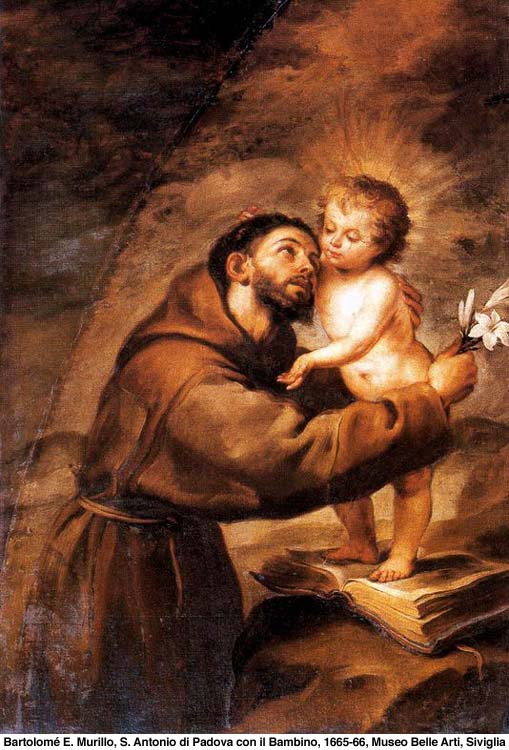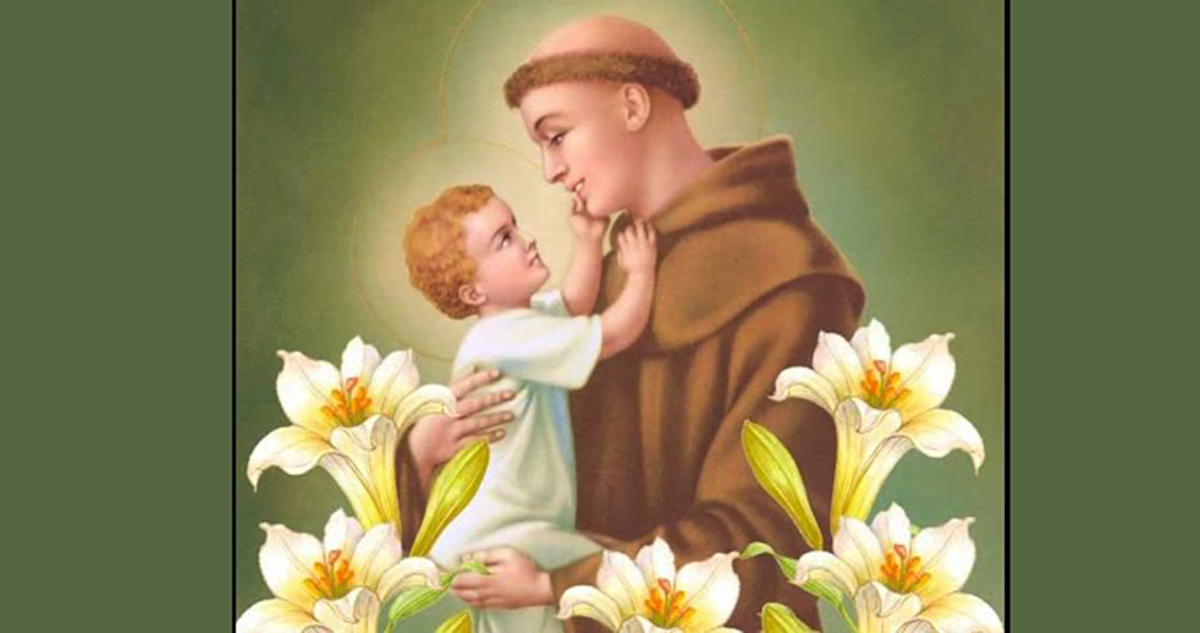Tempo di lettura: 11 minuti
Read the story of St. Anthony of Padua
Priest and "Doctor Evangelicus” (1195-1231)
Antonio di Padova (in portoghese António de Lisboa), al secolo Fernando Martim de Bulhões e Taveira Azevedo, nasce a Lisbona il 15 agosto 1195 da nobile famiglia portoghese discendente dal crociato Goffredo di Buglione.
At fifteen he was a novice in the monastery of San Vincenzo in Lisbon, then he moved to the monastery of Santa Croce in Coimbra, the largest cultural center in Portugal belonging to the Order of Canons Regular of St. Augustine, where he studied science and theology with excellent teachers, preparing for the priestly ordination which he will receive in 1219 at the age of twenty-four.
Quando sembra dover percorrere la carriera del teologo e del filosofo, decide di lasciare l’ordine agostiniano. Fernando, infatti, non sopporta i maneggi politici tra i canonici agostiniani e re Alfonso II, in cuor suo anela ad una vita religiosamente più severa.
His wish came true when, in 1220, the bodies of five Franciscan friars arrived in Coimbra, beheaded in Morocco, where they had gone to preach by order ofFrancis of Assisi. Quando i frati del convento di monte Olivares arrivano per accogliere le spoglie dei martiri, Fernando confida loro l’aspirazione a vivere nello spirito del Vangelo.
Having obtained permission from the Franciscan provincial of Spain and from the Augustinian prior, Fernando thus enters the hermitage of the Minors and immediately makes his religious profession, changing his name to Antonio in honor of the Egyptian hermit abbot.
Anelando al martirio, subito chiede ed ottiene di partire missionario in Marocco. È verso la fine del 1220 che s’imbarca su un veliero diretto in Africa, ma durante il viaggio è colpito da febbre malarica e costretto a letto. La malattia si protrae e in primavera i compagni lo convincono a rientrare in patria per curarsi. Secondo altre versioni, Antonio non si fermò mai in Marocco: ammalatosi appena partito da Lisbona, la nave fu spinta da una tempesta direttamente a Messina, in Sicilia.
Cared for by the Franciscans of the city, he healed in two months. At Pentecost he is invited to the General Chapter of Assisi; he arrives with other Franciscans at S. Maria degli Angeli where he has the opportunity to listen to Francis, but not to know him personally.
Il ministro provinciale dell’ordine per l’Italia settentrionale gli propone di trasferirsi a Montepaolo, presso Forlì, dove manca un sacerdote che dica la messa per i sei frati residenti nell’eremo composto da una chiesolina, qualche cella e un orto; Antonio accetta.
For about a year and a half he lives in contemplation and penance, carrying out, out of personal desire, the most humble tasks, until one day he goes down to the city with his brothers to assist, in the church of S. Mercuriale, at the ordination of new priests of the order and there he preaches in the presence of a vast audience, also made up of notables.
Since then Antonio has been assigned the role of preacher and teacher by Francesco himself, who writes him a letter recommending, however, not to lose the spirit of holy prayer and devotion.
He begins to preach in Romagna, continues in northern Italy, uses his word to fight heresy (he is also called "the hammer of heretics”) Cathar in Italy and Albigensian in France, where he arrived in 1225. Between 1223 and the latter date, in fact, he laid the foundations of the Franciscan theological school, teaching in the Bolognese convent of S. Maria della Pugliola.
Quando è in Francia, tra il 1225 e il 1227, assume un incarico di governo come custode di Limoges. Mentre si trova in visita ad Arles, si racconta gli sia apparso Francesco che aveva appena ricevuto le stigmate.
As custodian he took part in the General Chapter of Assisi in 1227 where the new minister of the Order - Francesco died in the meantime - was Giovanni Parenti, the provincial of Spain who had welcomed him years earlier among the Minors and who nominated him provincial of northern Italy .
Antonio opens new houses, visits the convents to get to know all the friars personally, controls the Poor Clares and the Third Order, goes to Florence, until he fixes his residence in Padua and in two months writes theSunday sermons.
In Padua he obtains the reform of the republican statutory code thanks to which an insolvent debtor, but without fault, after having sold all his assets cannot also be imprisoned. Not only that, he stands up to Ezzelino da Romano, who was nicknamed the Ferocious and who in a single day had eleven thousand Paduans who were hostile to him massacred, in order to free the imprisoned Guelph leaders.
Meanwhile he also writes iSermons for the feasts of the Saints, in which he delves into the themes dearest to him: the precepts of faith, morality and virtue, the love of God and pity towards the poor, prayer and humility, mortification and he rails against pride and lust, avarice and usury of which he is a bitter enemy.
He is a Mariologist, a convinced supporter of the Assumption of the Virgin, at the request of Pope Gregory IX (Ugolino dei Conti di Segni, 1227-1241) in 1228 he holds the sermons of the week of Lent and by this same Pp he is appealed "Ark of the Testament”. It is said that the sermons were held in front of a cosmopolitan crowd and that everyone heard him speak in their own language.
For three years Antonio travels tirelessly, he is tired, suffers from asthma and is swollen with dropsy, he returns to Padua and his sermons for Lent of 1231 are memorable.
Per riposarsi si ritira a Camposampiero, vicino Padova, dove il conte Tiso, che aveva regalato un eremo ai frati, gli fa allestire una stanzetta tra i rami di un albero di noce.
From here Antonio preaches, but also goes down to confess and in the evening he returns to his tree cell. One night, Count Tiso, having gone to check on Antonio, is attracted by a great light coming out of his refuge and witnesses the visit that Baby Jesus makes to the Saint.
At noon on Friday 13 June, Antonio feels weak and asks the confreres to take him to Padua, dove vuole morire. Caricato su un carro trainato da buoi, alla periferia della città le sue condizioni si aggravano al punto che si decide di ricoverarlo nel vicino convento dell’Arcella, dove muore in serata; si racconta che mentre stava per spirare ebbe la visione del Signore.
In the days following his death, they go on a rampage”internecine wars” tra il convento dove era morto che voleva conservarne le spoglie e quello di S. Maria Mater Domini, il suo convento, dove avrebbe voluto morire. Durante la disputa si verificano persino disordini popolari, infine, il padre provinciale decise che la salma sarebbe stata portata a Mater Domini.
Non appena il corpo giunse a destinazione iniziarono i miracoli, alcuni documentati da testimoni.
Even in life, in reality, Antonio had performed miracles such as exorcisms, prophecies, healings, including reattaching a severed leg, or making the heart of a miser be found in a casket, rendering poisoned foods harmless, preaching to fish, forcing a mule to kneel before the Host. His miracles - in life and after his death - have inspired many artists including Titian and Donatello.
Antonio, due to the mass of miracles attributed to him, was canonized the year following his death by PpGregory IX.
The large Basilica dedicated to him stands near the convent of S. Maria Mater Domini. Thirty-two years after his death, during the translation of his remains, Bonaventura da Bagnoregio (canonized in 1482) found Antonio's tongue uncorrupted, today kept in the Treasury Chapel at the basilica of the Paduan city of which he is patron.
The Venerable Pius XII (Eugenio Pacelli, 1939-1958), who in 1946 included St. Anthony among the Doctors of the Catholic Church, gave him the title of "Doctor Evangelicus”, as in his writings and in the sermons that have come down to us he used to support his statements with quotations from the Gospel.
Meaning of the name Antonio : “born before” or “who faces his adversaries” (Greek).
For further information: Life and Sermons of Saint Anthony
Catechesis of Pope Benedict XVI: St. Anthony of Padua
[Croatian,French,English,Italian,Portuguese,Spanish,German]

(source gospeloftheday.org)
His given name is Fernando. Portoghese, di Lisbona, nasce in una nobile famiglia nel 1195, si suppone il 15 agosto.
Ha 15 anni quando entra nell’Ordine dei canonici regolari di Sant’Agostino. Si prepara al sacerdozio a Coimbra, nel monastero della Santa Croce e, ordinato all’età di 24 anni, viene indirizzato alla carriera di teologo e filosofo.
But he meditates on a more severe religious life. The turning point came in 1220 when the remains of five Franciscan missionaries tortured and killed in Morocco arrived in the Church of the Holy Cross.
From the Augustinian Rule to the Franciscan Rule
Fernando decide di lasciare i canonici agostiniani e di seguire le orme di Francesco d’Assisi e sceglie di farsi chiamare Antonio, per imitare il santo anacoreta egiziano. Matura una forte spinta alla missione e con questo ideale parte alla volta del Marocco.
Ma contrae una malattia e, costretto al riposo forzato, non può predicare. Non gli resta che rientrare in Italia. La nave sulla quale è imbarcato naufraga e giunge in Sicilia. Antonio viene curato e nel 1221 raggiunge Assisi, dove Francesco ha convocato tutti i suoi frati.
Here is a good opportunity to meet him in person. It's a simple meeting; Antonio strengthens his choice to follow Christ in the Franciscan fraternity and minority and is sent to Romagna, to the hermitage of Montepaolo. Here he dedicated himself above all to prayer, meditation, penance and menial work.
Anthony preacher
Nel settembre 1222 Antonio è invitato a predicare a Forlì: è la rivelazione del suo talento. Dalle sue parole emergono la profonda cultura biblica e la semplicità d’espressione.
TellsThe Assidua, la prima biografia di Sant’Antonio: “La sua lingua, mossa dallo Spirito Santo, prese a ragionare di molti argomenti con ponderatezza, in maniera chiara e concisa”.
Da allora Antonio comincia a percorrere il Nord Italia e il Sud della Francia, predicando il Vangelo a genti e Paesi spesso confusi dalle eresie del tempo, senza risparmiare parole di correzione per la decadenza morale di alcuni esponenti della Chiesa.
The following year in Bologna he was master of theology for the friars in formation; Francis himself gave him the task and in a letter authorized him to teach, recommending that he not neglect prayer.
The choice of Padua
Per i talenti che dimostra di saper mettere a servizio del Regno di Dio, Antonio, all’età di 32 anni, viene nominato superiore delle fraternità francescane del Nord Italia. In tale veste non si risparmia nelle visite ai numerosi conventi sotto la sua giurisdizione, ne apre di nuovi.
Intanto continua a predicare e ad attirare grandi folle, a trascorrere diverse ore nel confessionale e a riservarsi momenti per ritirarsi in solitudine. Sceglie di risiedere a Padova, nella piccola comunità francescana della chiesa di Santa Maria Mater Domini e, pur sostandovi per brevi periodi, instaura con la città un fortissimo legame, prodigandosi anche per i poveri e contro le ingiustizie.
And it was in Padua that iSermones, un trattato per formare i confratelli alla predicazione del Vangelo e all’insegnamento dei sacramenti, soprattutto la penitenza e l’eucaristia. La predicazione nella Quaresima del 1231 è considerata il suo testamento spirituale, cui è da includere la sua amorevole dedizione, per ore e ore, alle confessioni.
Celebrata la Pasqua, Antonio, già provato da problemi di salute e logorato dalle fatiche, acconsente a ritirarsi per un periodo di convalescenza; poi, con altri confratelli, accoglie l’invito a un periodo di riposo e meditazione in un piccolo romitorio a Camposampiero, a pochi chilometri da Padova. Chiede che gli venga adattato un semplice rifugio sopra un grande albero di noce, per trascorrere le giornate in contemplazione e dialogando con la gente semplice del borgo di campagna, rientrando nell’eremo solo la notte.
È qui che avviene la visione di Gesù Bambino. Il 13 giugno Antonio è colto da un malore; capisce che la sua ora è vicina e domanda di poter morire a Padova. Viene trasportato su un carro trainato da buoi, ma giunto all’Arcella, borgo alle porte della città, spira mormorando: “Vedo il mio Signore”.
Debtor to Saint Augustine in his thoughts, Antonio combined mind and heart, the pursuit of speculation and the exercise of virtue, study and prayer in an original way. Doctor of the Church, in Padua he is simply called "the Saint".
source © Vatican News – Dicastery for Communication










